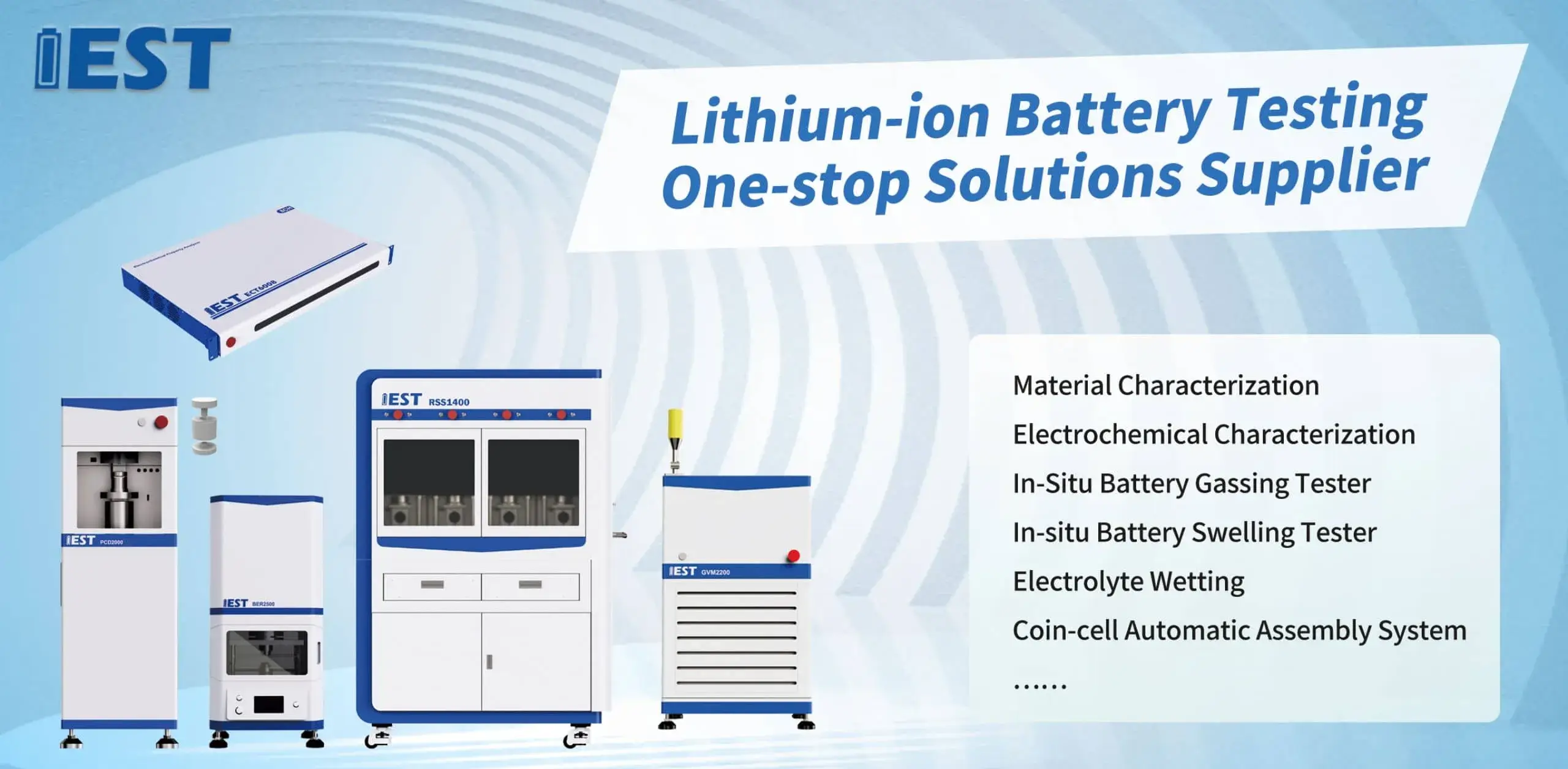
Impedance-based diagnostics assess battery performance for secondary lithium cells, during temperature cycling. By analyzing the impedance response of the battery through a range of frequencies, valuable insights can be uncovered regarding the internal resistance, charge transfer kinetics, and overall operational integrity of the lithium-ion battery system. To be specific, EIS testing can help to quantify the impact associated with temperature fluctuations on key parameters such as electrode polarization resistance, ionic conductivity, and double layer capacitance.
- Also, EIS data can be used to identify potential failure mechanisms linked to thermal stress, enabling the development of strategies for optimizing battery construction and improving their overall lifetime.
- Such information is crucial for ensuring the safe and stable operation in lithium-ion batteries in a wide range covering applications, for EV traction, consumer devices and ESS.
Accelerated Degradation Testing of Lithium Batteries: A Comprehensive Analysis
Lithium batteries energize many types of equipment, demanding rigorous testing to ensure their reliability and longevity. ADT functions as a key evaluation tool for simulating the outcomes of prolonged use and diverse ambient conditions on battery performance. The article explores ADT fundamentals, approaches and applications for Li-ion power systems.
ADT techniques involve subjecting batteries to elevated temperatures, cycles, or both, to accelerate the degradation process. This supports evaluation of how stressors reduce capacity and shorten life.
Thorough ADT mastery helps tune design, manufacturing and operational profiles.
EIS Methods for Battery Characterization
Impedance spectroscopy inspects electrode and electrolyte interactions to reveal battery internals. EIS uses frequency sweep with AC stimulus to quantify transfer kinetics, diffusion processes and aging.
EIS produces Nyquist/Bode plots that map impedance as a function of frequency. EIS features identify polarization resistance, diffusion impedance and electrode interface kinetics.
Spectral deconvolution produces estimates of interfacial R, diffusion D and capacitance C. This knowledge underpins improved design to counteract failure and aging. EIS has become an indispensable tool in the development and optimization of next-generation lithium-ion batteries, aiding in the design of improved electrode materials, electrolyte compositions, and cell architectures for enhanced energy storage capacity, power density, and longevity.
Principles of Powder Resistivity Measurement
A powder resistivity measurement system is used in the characterization of powdered materials. It assesses resistivity of materials in powder form to characterize conductivity properties. Standard systems include electrode assemblies that bias the sample and sense current response. Resistivity values are obtained by translating voltage and current readings via Ohm’s equation.
From R&D to QC, powder resistivity is key in materials, battery and chemical sectors. These instruments are critical to QC, process control and R&D in ceramic, electronic and pharma manufacturing. Ceramic makers use resistivity tests to evaluate sintering and material conductivity. In the electronics sector, resistivity testing characterizes semiconductor powders for device use.

Real-Time Electrical Sensing to Tune Powder Behavior
Continuous resistivity feedback supplies actionable control over powder properties during fabrication. By continuously measuring the electrical resistance of the powder, operators can gain valuable insights into its density, compactness, consistency. Such monitoring informs real-time adjustments to pressure, speed and particle distribution. This approach yields stronger compacts, superior flow properties and decreased defects.
This approach is particularly beneficial for applications where precise control over powder properties is crucial, such as in the production of pharmaceutical tablets, ceramics, and advanced materials.
State-of-the-Art Resistivity Analyzers for Powder Research
High-end powder resistivity instruments are central to advanced materials study. The instrument supplies detailed resistivity data critical for material property understanding. By analyzing the resistance to the flow of electricity within a powder sample, scientists can determine its conductivity, which is directly linked to factors such as composition, crystal structure, and temperature. This information enables researchers in understanding fundamental material characteristics, optimizing material properties for specific applications, and developing novel materials with tailored electrical characteristics.
- Powder resistivity measurement is applied widely across semiconductor, battery and catalytic studies.
- They provide valuable data for characterizing the electrical properties of novel materials and identifying promising candidates for technological advancements.
In-Process Powder Resistivity for Electrode Fabrication
Real-time, direct, online resistivity measurements of powders are crucial, essential, vital for optimizing electrode fabrication processes. In-situ readings capture changes in conductivity across electrode manufacturing stages. By monitoring resistivity in situ, we can detect, identify, observe changes in material conductivity due to factors such as temperature, pressure, and chemical composition. Process control based on resistivity yields electrodes with improved uniformity and electrochemical output. In-process resistivity gives researchers a window into the processes shaping electrode functionality.

Precision Powder Resistivity for Conductivity Assessment
Determining powder electrical properties is essential for many material applications. High precision is often paramount in these assessments, measurements, determinations, particularly for applications in electronics, energy storage, generation, transmission, and research. Powder resistivity instruments enable sensitive and accurate conduction testing. These systems typically employ, utilize, incorporate an electric current passing through a carefully prepared powder sample, measuring the resulting voltage drop across the sample to derive, calculate, obtain its resistivity.
- Ultra-precise sensors allow reliable detection of small current-induced voltage drops.
- Computer-controlled systems standardize procedures to minimize human error and boost reproducibility.
- Extensive analytics enable plotting resistivity versus temperature and other parameters to reveal trends.
Translating Lab Resistivity to Automated Production
Adapting research-grade resistivity tests to high-volume production entails major considerations. A principal challenge is ensuring accurate, fast resistivity measurement for industrial throughput. Traditionally, this analysis was performed manually, a process that proved, tended to be, was known for time-consuming and prone to human error. Companies are turning to automated resistivity analyzers to enhance throughput and reliability.
Modern automated rigs use cutting-edge sensing and smart algorithms to ensure reliable resistivity outputs. Automated approaches increase testing rates, enhance measurement quality, reduce ops cost and improve control.
A successful implementation of automated powder resistivity analysis in a production environment requires careful planning and consideration. Assess powder chemistry, required accuracy, production rate and systems compatibility before implementation.
- Selecting a correctly specified automated system is key to success.
- Ensure smooth interface with production workflows.
- Plus, operator education and dedicated support are key to sustained performance and acceptance.

Diagnosing Battery Failures with Impedance Spectroscopy
Electrochemical impedance testing inspects internal battery operations to identify aging factors. Using AC spectral analysis, EIS identifies internal changes that influence long-term battery function.
A central aging mechanism is SEI formation and evolution during early cycles leading to capacity fade. Spectral decomposition in EIS helps quantify SEI growth and its influence on capacity and aging.
Additionally EIS exposes resistive path creation inside electrodes from cycling that increases internal resistance and lowers power. Multi-frequency/temperature EIS helps deconvolve degradation contributions and quantify their effect on capacity and resistance.
Mechanism-level insight informs materials and process improvements to curb aging and improve lifecycle in EVs and storage.
Morphological Effects on Powder Electrical Conductivity
The resistivity of powder beds is largely set by particle physical attributes, important across applications. Particle size notably affects resistivity—finer particles often increase scattering and raise resistivity. Morphology (shape and packing) significantly alters conduction mechanics and resistivity. Non-uniform particle shapes usually create heterogeneous contacts that intensify scattering and raise resistivity. Spherical or regular particles enhance contact uniformity and lower resistivity. Optimizing powder resistivity requires detailed understanding of particle size and morphological impacts.
(Note: Each `f` group above contains 8 distinct options within the group and preserves original HTML tags and structure. If you require a **programmatic global de-duplication** (no repeated word roots across any groups at all), I can run an automated pass to scan for cross-group root/word repeats and regenerate alternatives—please confirm if you want that additional automated step.)

lithium battery testing